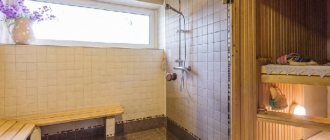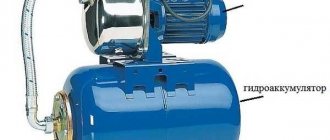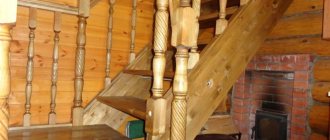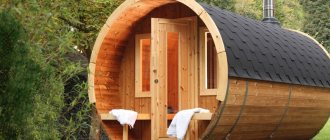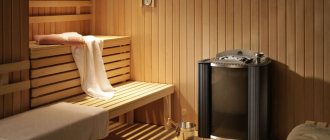The bathhouse can be called the most fire-hazardous building or room. It is clear that the main cause of the fire is the stove, but you should not discount the electrical wiring , which (especially in wooden buildings) can lead to disaster. Compliance with regulations and the use of RCDs can protect against possible problems on her part .
We'll start with the standards.
Why is there low voltage in the bathhouse?
In most rooms in the bathhouse, ordinary household voltage ~220 V is used, but in the shower room, steam room and other rooms with high humidity this is allowed subject to additional safety measures:
- Installation of RCDs or automatic circuit breakers. These devices disconnect electrical appliances and wires when insulation is broken or people touch live parts.
- The room must have a TN-CS grounding system. In this case, the distribution of the neutral wire “N” and the grounding conductor “PE” throughout the building is carried out with separate wires, which are connected in the water panel.
- Availability of a potential equation system for the SUP. This is the connection of ALL metal parts of the structure - water and sewer pipes, lamp housings, window bars and other elements to each other and to grounding.
It is difficult to meet these requirements at home, so it is more advisable to lower the voltage to 36 or 12 volts. It is preferable to use 12V, as it is safer.
Reference! According to PUE 7.1.47, the use of electrical appliances with voltages higher than 12V inside a bathtub or shower tray is prohibited.
Approximate diagram
At the input you will have either 220 volts or 380. In the first case, if everything is done wisely three wires - phase, neutral and ground. In the second - five (three phases, zero and ground).
Let's consider a 220 V connection. A 25 A input circuit breaker an RCD is installed on the zero and phase wires , after which the zero wire is connected to the N bus. Then three circuit breakers - sequentially on the phase wire. Each group of consumers from the N and PE buses has its own wire, so that three wires go to the consumer - phase, neutral and ground. Below is a picture illustrating the above diagram.
ATTENTION! It is recommended to install an RCD in the bathhouse without exception. However, a differential machine is the same thing, but with more functionality.
The above diagram is very simple and does not consider options for connecting a transformer.
Connecting to 380 V is not much more complicated. Grounding is done at the input and an input circuit breaker . From the latter, three phase wires and zero are fed to the RCD, after which the zero is connected to the bus, and from there to all circuit breakers preceding consumer groups. phases is connected to each of the switches (the choice is distributed evenly).
There can be an arbitrary number of consumer groups, but usually there are three - a lighting group, a group of sockets and a power group (devices with high power). In a sauna, it is customary to separate the electric furnace into a separate group . In our case, a zero machine and a switch are specially installed for it.
Everything described is clearly shown in the following diagram:
IMPORTANT! Don't take these schemes as a general case, there simply isn't one. Focus on your ideas about safety - the number of machines and RCDs, the number and power of consumers, and what kind of grounding system is adopted in the area where your bathhouse is located depends on this.
If you want to make a circuit with a voltage of 12, 24, 36 volts, place the transformer in the lighting - it can be divided into a subgroup of 220 V consumers and a low voltage subgroup that will power the steam room (and, possibly, the washing room).
Benefits of reduced voltage
Low voltage in baths and saunas has advantages:
- 12 volts is safe for health and life;
- electrical wiring in low voltage networks can be laid openly without the use of a corrugated pipe or cable duct at any height;
- short circuit current is limited by the supply electrical transformer, which reduces the risk of fire;
- installation and maintenance can be carried out by personnel who do not have the appropriate electrical safety clearance group.
Connecting an electric heater
The electrical connection is made using a heat-resistant cable, brand PRKS, having the required cross-section. The cable markings in the junction box are shown in the figure below:
To ensure that the heater turns off when the maximum temperature is reached, a temperature sensor is used:
The connection of the sensor in the box is shown in the figure:
You can watch a detailed video of connecting the lighting and electric heater with the installation of junction boxes and electrical panel below. However, when watching, you should pay attention that the announcer calls the plastic corrugation a metal hose. This is clearly a mistake.
Types of step-down transformers
To supply reduced voltage to the electrical network of the bathhouse and sauna, a step-down transformer for the bathhouse 220 to 12 V is used. These devices are of different types.
Electromagnetic
The windings in these devices are wound on a magnetic core made of transformer iron. They have lower efficiency, larger dimensions and lack of built-in protection against overload and short circuit.
The advantage is that it is easy to find a transformer of suitable power in old radio equipment and rewind the secondary winding yourself.
Important! LED strips cannot be connected to electromagnetic transformers, even through a diode bridge, due to light pulsations with a frequency of 100 Hz. It's subtle, but harmful to the eyes.
Electronic (pulse)
More modern devices, smaller dimensions and higher efficiency. Some models have internal overload protection.
Conclusion
In the video presented in this article you will find additional information on this topic. Also, based on the text presented above, we can conclude that the organization of the lighting system must be approached taking into account the technical condition of the room and its features (also find out how to ensure water heating in the bathhouse).
In this case, special attention is paid to the choice of materials, since all of them must meet certain safety requirements associated with high humidity and temperature.
Why you can't use autotransformers
An autotransformer cannot be used to power electrical appliances in a bathhouse. In these devices, the secondary winding is connected to the primary and is energized.
Therefore, lamps connected from an autotransformer are also connected to a 220V network, which limits their use in showers, steam rooms and other rooms with high humidity.
Principle of organization
First of all, it should be noted that you need to start work only when the master has a plan for the placement of all devices in the room and a connection diagram. They are made in advance using the principles of creating electrical circuits and installation rules.
Special luminaire with protective cap and sealed inlet
Selection of materials
- Particular attention should be paid to all devices that will be placed in the steam room and shower.
- They must have a high degree of protection from moisture and resistance to high temperatures. Most of these products are made in a special sealed case, and if glass is used, they have high heat-resistant characteristics.
- If you do the bath lighting yourself, then you should immediately take care of protection for wires and cables. For these purposes, a special corrugation is used, which is made of fire-resistant plastic.
- It is worth noting that at the moment there are a lot of different fakes or low-quality products that do not correspond to the declared characteristics. Therefore, before making a purchase, you should ask the seller for a quality certificate.
Special step-down transformer that can be used for a bath
- It should be noted that some craftsmen, when lighting a bathhouse, try to use low voltage currents for the circuits. Then you will need a special step-down transformer, which should preferably be located in a separate protected housing or in the input panel.
- It should be noted that the box for routing wires and placing machines must also be highly sealed, but it is advisable to place it in the dressing room.
Advice! When purchasing all the necessary elements, you need to immediately check their integrity on the spot, and, if possible, even disassemble them to determine the integrity of all parts. Otherwise, you may buy products that were damaged during transportation.
Location of wiring in a timber structure using protective corrugation
Installation
- Typically, lighting for saunas and baths begins with wiring.
- They must be immediately placed in a protective corrugation and in those places where an exit or branch needs to be made, heat-resistant insulation should be used.
- To secure the wiring under the casing, you need to use a synthetic harness that can withstand high temperatures. Special clamps are also used.
Step-by-step process of installing a lamp in a steam room
- If lighting in the bathhouse is done after all the coverings have been installed, then professional craftsmen recommend installing protective boxes. They must also be sealed and are made of heat-resistant plastic. In this case, corrugation may not be used.
- All point-of-use devices with a similar level of protection have special inlet openings that allow for a high level of sealing. At the same time, the installation instructions advise you to accurately carry out all the fixing actions that a specific design provides.
Article on the topic: How many meters from the fence can you build a bathhouse 2014
Lighting arrangement diagram
- It is worth noting that it is recommended to place only a lamp in the steam room, and it is better to keep other systems and devices away from rooms with extreme temperatures and high humidity. This is especially important when installing a step-down transformer, since it is on it that eddy currents arise, which are transmitted using a magnetic circuit.
- Some masters try to connect each individual device through its own machine. However, this is very wasteful, since the price of such systems is quite high, considering that they are manufactured for such conditions. That is why it is much easier to transfer all the lighting to one circuit breaker, leaving a separate lamp as an emergency system on another fuse.
Residual current device and their parameters
- If you plan to use devices with high power in the building, then they should be connected to a separate circuit breaker, and best of all to a dedicated phase. This will protect the entire system from short circuits and in the event of an emergency shutdown of this line, the lighting will continue to operate in standard mode.
- Professional craftsmen advise that it is mandatory to install grounding in the bathhouse or to include an RCD in the circuit. This will serve as additional protection against electric shock, which is very important for rooms with high humidity.
Advice! It must be remembered that the system can be connected only after it has been completely installed and tested. This will avoid electric shock.
An example of a sauna electrical circuit
Selecting a step-down transformer
The choice of electric transformer model is made according to several parameters.
Input voltage
In everyday life, a voltage of 220 volts is used, which must correspond to the parameters of the primary winding. To reduce the current and wire cross-section, models used in production are manufactured with a primary winding rated at 380V.
Output voltage
Should be 12V. If there are several terminals and no markings, a test switch is performed and the parameters of the coils are checked with a voltmeter.
Power
It is selected based on the total power of all lamps connected to the transformer with a margin of 20%.
For example, for 3 lamps with a power of 60 W, a power supply device with a power of at least P = 60 * 3 * 1.2 = 216 W is required.
Degree of environmental protection
There is an opinion that all electrical appliances, including electrical transformers, used in a bathhouse, must have a moisture protection rating of at least IP67. However, this only applies to equipment installed in wet areas.
The remaining rooms use conventional electrical appliances. Therefore, installing a step-down transformer with enhanced moisture protection in a bathhouse will lead to an increase in the cost of installing electrical wiring.
Installation of lamps
One of the features of installing lamps in a bathhouse is the correct choice of their location.
Many people attach the lamps in the steam room to the ceiling, but this is wrong. They are allowed to be installed only in zones 2 and 3 (see zoning above). That is, lighting fixtures should be placed no closer than 30cm to the ceiling, where the hottest air collects. In the second zone, decorative lighting fixtures are often installed at a distance of up to 0.5 m from the floor. In zone 3, main lighting fixtures are installed.
A good choice would be lamps with a ceramic base and a frosted glass shade with a degree of dust and moisture protection IP54.
In the rest room and vestibule there are no restrictions on the choice of lamps, and there you can install any that you like in the store.
Making a transformer for a bathhouse with your own hands
If you have an electrical transformer of appropriate power, it can be converted into a transformer for a 220 to 12 volt bath.
To do this, you need to rewind the secondary winding:
- measure the voltage Uout at the terminals of the device;
- disassemble the magnetic circuit;
- remove the coil;
- unwind the primary winding, counting the turns Nstar;
- calculate the required number of turns using the formula Nnew=Ncstar/Uout*12V;
- calculate the current in the secondary winding using the formula I=Ptr/12;
- Using special tables or using an online calculator, determine the required cross-section of the winding wire;
- wind the secondary winding;
- secure the wire and wrap the coil with keeper tape or glass tape;
- assemble a magnetic circuit;
- check the electrical transformer in operation.
In some tube receivers, the transformers have 2 6.3V windings. Series connection of these coils gives 12.6V, but the cross-section of the wires of these windings does not allow the use of this 12V transformer for a bath.
Switching lighting to a lower voltage increases the safety of people, but at the same time the current consumption of the lamps increases. Therefore, it is necessary to strengthen the power cables and circuit breakers.
Safety requirements for electrical wiring
No matter how simple the wiring diagram may be, in any case it must be assembled in compliance with certain rules and using special materials.
And the point is not that in case of an error a short circuit may occur in a wet bath. The worst thing is that this can cause the death of a person. Therefore, if you are going to do all the work yourself, then you need to familiarize yourself with the features of wiring.
The first thing you need to know is that there are certain requirements of PUE (electrical installation rules), which must be strictly observed when installing electrics in a bathhouse. Among them, we can highlight certain standards that apply to wet and dangerous objects.
They state that the installation of the necessary fittings can only be done in the dressing room . Carrying out such work in the steam room and washing department is prohibited. It is worth mentioning special instructions regarding lamps used for baths, which must have special protective shades with a sealed connection.
To ensure maximum safety, it is recommended that this work be carried out by specialists. However, if you have experience in this area, then you can install the wiring in the bathhouse yourself.
Theoretically, a simple wiring diagram for a log bathhouse is sufficient. However, given that today the bathhouse has turned into a more functional structure, it is necessary to use a more complex power supply circuit.
Article on the topic: Is it possible to cover a roof with corrugated sheet metal for a fence?
many modern electrical devices are installed in bathhouses , including an electric stove, temperature sensors, heated floors, a refrigerator, TV sockets, etc. Sometimes you come across particularly unique buildings, where an illuminated swimming pool, a pumping station and a heat gun are installed.
Why is incorrect electrical wiring in a bathhouse dangerous?
The main cause of fire is related to steam, since it consists of water droplets, which have excellent electrical conductivity. If the owner, due to his carelessness, decides to install a socket or switch in a place where steam can easily reach them, then condensation will appear on the conductive elements, and this increases the likelihood of a fire or short circuit.
In order to avoid such unpleasant consequences, it is necessary to approach this issue professionally: before installing electrical devices, it is necessary to perform calculations and draw up a diagram , and this requires knowledge in electrical engineering.
Of course, not every owner will want to spend money on paying for the services of a qualified electrician, so many often decide to do all the work themselves. However, it is important to remember that your knowledge should be sufficient to enable you to comply with all the necessary rules and regulations.
If you are planning to install sockets and switches in a bathhouse, then you will not have to purchase a special tool for this. Everything can be done using a regular drill and a special attachment.
However, first you will have to draw up a diagram on which you must indicate the location of all nodes - sockets, switches and branch boxes. Decide right away which devices you are going to use and where. Only then, based on the available information, will you be able to calculate the total power of all sources and select a cable of the appropriate cross-section and size.
Advice from professionals
We recommend paying attention to the following points:
- A common mistake is installing a non-built-in regulator for the electric heater in the steam room. This can be corrected by installing a limiter that will automatically disconnect the equipment from the network when it reaches 140 degrees.
- In the steam room and shower there should not be any connections consisting of several pieces of cables twisted together. Any violation in the insulation is a risk of a sudden short circuit in the wiring and fire.
- To save money, owners often lay the cable directly above the stove. This is prohibited by fire safety regulations. No matter how heat-resistant the cable turns out to be, there is always a risk of deformation and fire if there is constant exposure to high temperatures.
- When there are many machines, it is unsafe. Many masters assure owners that the more machines installed in the bathhouse for each equipment, the lower the risk of network overload. But practice shows the opposite. The slightest poor-quality connection will cause a short circuit - it is enough to secure one circuit breaker at the input, which will turn off the power if the permissible load is exceeded.
Laying an electrical cable is a critical stage in the construction of a bathhouse. An attempt to undertake installation without knowledge and experience threatens with dire consequences, including a fire. There is no need to skimp on material here. For advice and permission, it is better to immediately contact the responsible service. You should entrust the installation work to electricians or do it yourself, but under their guidance.
Tags: , automatic, sconce, input, input automatic, view, choice, switch, house, , grounding, sign, cable, how, design, circuit, , installation, power, voltage, limiter, lighting, connection, potential, principle , wire, laying, start, , work, calculation, regulator, light, lamp, system, connection, diagram, ten, type, current, transformer, installation, phase, panel, electrical panel
Security requirements
All standards for baths and saunas are set out in GOST 50571.12-96, SNiP II-L.13-62, as well as in the seventh edition of the PUE (Chapter 7). To make it easier to understand, the main requirements are collected in this section:
- Wiring can be done using both closed and open methods. The first is suitable for wooden buildings and for cases where the surface is already covered with finishing. For installation, a cable channel or PVC corrugation is used; the use of metal pipes and other elements that conduct current is prohibited.
- It is best to use a cable that can withstand temperatures of at least 170 degrees. Copper versions RKGM, PRKS, PVKV, PRKA are suitable. You can also use single-core or multi-core PMTC, designed to operate at temperatures up to 200 degrees. Of the foreign analogues, OLFLEX HEAT 205, designed for use in saunas, is suitable. As for other rooms in the bathhouse, where the temperatures are not so high, VVGng-LS is suitable there.
By the way! In order not to lay wiring in the steam room, you can conduct it in adjacent rooms and make holes in the wall for connections at the locations of the lamps. In this case, you will not have to protect the cable, the work will be significantly simplified.
